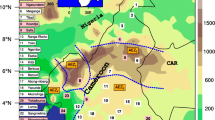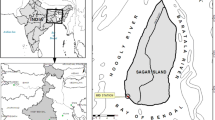Abstract
The commencement, termination and length of the major (Maha) growing season over the dry zone of Sri Lanka were determined using daily rainfall records from 1981 to 2019 of five meteorological stations (Anuradhapura, Polonnaruwa, Hambantota, Puttalam and Batticaloa). Cumulative percentages of daily rainfall were plotted against the time and maximum positive and maximum negative curvatures were derived as the commencement and termination dates of the season. A Gaussian model was fitted on the cumulative distribution curve in order to remove limitations in deriving maximum positive and maximum negative curvatures. The difference between commencement and termination dates was taken as the length of the growing season. Results disclosed that there is a considerable inter-annual variation of commencement and termination dates and the length of the Maha season. Mean commencement and termination dates fall in the standard week 44.04 ± 2.61 (end of October) and 5.10 ± 4.20 (1st week of February). The average seasonal length is 13.7 ± 4.24 weeks. The terminating date acts as the key determinant of the seasonal length. Any significant (p > 0.05) trend could not be observed for commencement, termination and length of the season for the analyzed period in any of the locations. It can be concluded that cumulative distribution of rainy days can be successfully used to determine commencement and termination dates of the Maha season over the dry zone of Sri Lanka where a single peak rainy period is characteristic. However, the method needs modifications, when it applies in the wet zone of the country where bimodal rainfall pattern is prominent.






Similar content being viewed by others
Data availability
Available from the authors upon request.
Code availability
Not applicable.
References
Adejuwon JO, Odekunle TO (2006) Variability and the Severity of the “Little Dry Season” in Southwestern Nigeria. J Clim 19:483–493. https://doi.org/10.1175/JCLI3642.1
Adejuwon JO, Balogun EE, Adejuwon SA (1990) On the annual and seasonal patterns of rainfall fluctuations in sub-Saharan West Africa. Int J Climatol 10:839–848. https://doi.org/10.1002/joc.3370100806
Ampitiyawatta AD, Wijeratne AW (2015) Impact of temporal changes of rainfall on major climatic zones of Sri Lanka. Trop Agric Res Ext 18:148–152
Basnayake BRSB (2007) Climate change. In: The National Atlas of Sri Lanka. Survey Department of Sri Lanka, Colombo, Sri Lanka, pp 54–55
Benoit P (1977) The start of the growing season in Northern Nigeria. Agric Meteorol 18:91–99. https://doi.org/10.1016/0002-1571(77)90042-5
Central Bank of Sri Lanka (2020) Annual Report. Volume 1. Central bank of Sri Lanka, Colombo, Sri Lanka
Domroes M (1974) The Agroclimate of Ceylon. Franz Steiner Verlag, Wiesbaden
Guenang GM, Mkankam Kamga F (2012) Onset, retreat and length of the rainy season over Cameroon. Atmospheric Science Letters 13:120–127. https://doi.org/10.1002/asl.371
Hachigonta S, Reason CJC, Tadross M (2008) An analysis of onset date and rainy season duration over Zambia. Theor Appl Climatol 91:229–243. https://doi.org/10.1007/s00704-007-0306-4
Holland GJ (1986) Interannual Variability of the Australian Summer Monsoon at Darwin: 1952–82. Mon Weather Rev 114:594–604. https://doi.org/10.1175/1520-0493(1986)114%3c0594:IVOTAS%3e2.0.CO;2
Hussein J (1987) Agroclimatological analysis of growing season in natural regions III, IV and V of Zimbabwe. In: Cropping in the semiarid areas of Zimbabwe. Agric. Tech. and Ext. Serv./Dep. of Res. and Spec. Serv./ Deutsche Gesellschaft f r Technische Zu¨sammenarbeit, Harare, Zimbabwe, pp 25–89
Ilesanmi OO (1972a) An empirical formulation of the onset, advance and retreat of rainfall in Nigeria. J Trop Geogr 34:17–24
Ilesanmi OO (1972b) Aspect of the precipitation climatology of the July–August rainfall minimum of southern Nigeria. J Trop Geogr 35:51–59
Jayawardene HKWI, Sonnadara DUJ, Jayewardene DR (2005) Spatial interpolation of weekly rainfall depth in the dry zone of Sri Lanka. Climate Res 29:223–231. https://doi.org/10.3354/cr029223
Kinsey B, Burger K, Gunning JW (1998) Coping with drought in Zimbabwe: Survey evidence on responses of rural households to risk. World Dev 26:89–110. https://doi.org/10.1016/S0305-750X(97)00124-1
Laux P, Kunstmann H, Bárdossy A (2008) Predicting the regional onset of the rainy season in West Africa. Int J Climatol 28:329–342. https://doi.org/10.1002/joc.1542
Marteau R, Sultan B, Moron V et al (2011) The onset of the rainy season and farmers’ sowing strategy for pearl millet cultivation in Southwest Niger. Agric for Meteorol 151:1356–1369. https://doi.org/10.1016/j.agrformet.2011.05.018
Mupangwa W, Walker S, Twomlow S (2011) Start, end and dry spells of the growing season in semi-arid southern Zimbabwe. J Arid Environ 75:1097–1104. https://doi.org/10.1016/j.jaridenv.2011.05.011
MATLAB (2017) version 9.3.0.713579 (R2017b), Natick, Massachusetts: The MathWorks Inc
Nisansala WDS, Abeysingha NS, Islam A, Bandara AMKR (2020) Recent rainfall trend over Sri Lanka (1987–2017). Int J Climatol 40:3417–3435. https://doi.org/10.1002/joc.6405
Odekunle TO (2006) Determining rainy season onset and retreat over Nigeria from precipitation amount and number of rainy days. Theor Appl Climatol 83:193–201. https://doi.org/10.1007/s00704-005-0166-8
Olaniran OJ (1983) The onset of the rains and the start of the growing season in Nigeria. Nigerian Geographical Journal 26:81–88
Omotosho JB (1990) Onset of thunderstorms and precipitation over Northern Nigeria. Int J Climatol 10:849–860. https://doi.org/10.1002/joc.3370100807
Omotosho JB (2002) Synoptic meteorology: pathway to seasonal rainfall prediction for sustainable agriculture and effective water resource management in West Africa but Nigeria in particular. Journal of the Nigerian Meteorological Society 3:81–89
Punyawardena BVR (2002) Identification of the potential of growing season by the onset of seasonal rains: A study in the DL1 region of the north central dry zone. Journal of National Science Foundation Sri Lanka 30:13–21
Punyawardena BVR, Kulasiri D (1996) On development and comparative study of two Markov models of rainfall in the dry zone of Sri Lanka. Research Report 96/11, Lincoln University
Raes D, Steduto P, Hsiao TC, Fereres E (2009) AquaCrop—The FAO Crop Model to Simulate Yield Response to Water: II. Main Algorithms and Software Description. Agron J 101:438–447. https://doi.org/10.2134/agronj2008.0140s
Ramesh Kumar MR, Sankar S, Reason C (2009) An investigation into the conditions leading to monsoon onset over Kerala. Theor Appl Climatol 95:69–82. https://doi.org/10.1007/s00704-008-0376-y
Sivakumar MVK (1990) Exploiting rainy season potential from the onset of rains in the Sahelian zone of West Africa. Agric for Meteorol 51:321–332. https://doi.org/10.1016/0168-1923(90)90116-N
Sonnadara DUJ (2015) The onset, retreat and the length of growing season in the north-eastern region of Sri Lanka. Int J Climatol 35:3633–3639. https://doi.org/10.1002/joc.4237
Sonnadara DUJ, Jayewardene DR (2015) A Markov chain probability model to describe wet and dry patterns of weather at Colombo. Theor Appl Climatol 119:333–340. https://doi.org/10.1007/s00704-014-1117-z
Stern RD, Dennett MD, Garbutt DJ (1981) The start of the rains in West Africa. J Climatol 1:59–68. https://doi.org/10.1002/joc.3370010107
Stewart JL (1988) Response Farming in Rainfed Agriculture. The WHARF Foundation Press, Davis, CA
Suppiah R (1996) Spatial and Temporal Variations in the Relationships Between the Southern Oscillation Phenomenon and the Rainfall of Sri Lanka. Int J Climatol 16:1391–1407. https://doi.org/10.1002/(SICI)1097-0088(199612)16:12%3c1391::AID-JOC94%3e3.0.CO;2-X
Tadross MA, Hewitson BC, Usman MT (2005) The Interannual Variability of the Onset of the Maize Growing Season over South Africa and Zimbabwe. J Clim 18:3356–3372. https://doi.org/10.1175/JCLI3423.1
Thambyahpillay G (1954) The rainfall rhythm in Ceylon. University of Ceylon Review 12:224–273
Vellinga M, Arribas A, Graham R (2013) Seasonal forecasts for regional onset of the West African monsoon. Clim Dyn 40:3047–3070. https://doi.org/10.1007/s00382-012-1520-z
Wang YH, Fan CR, Zhang J et al (2015) Forecast Verification and Visualization based on Gaussian Mixture Model Co-estimation. Computer Graphics Forum 34:99–110. https://doi.org/10.1111/cgf.12520
Watanabe T, Takenaka H, Nohara D (2020) Framework of Forecast Verification of Surface Solar Irradiance From a Numerical Weather Prediction Model Using Classification With a Gaussian Mixture Model. Earth and Space Science 7:e2020EA001260. https://doi.org/10.1029/2020EA001260
Wimalasiri EM, Ashfold MJ, Walker S et al (2017) The relationship between rainfall characteristics and Proso millet (Panicum miliaceum L.) cultivation in low country dry zone, Sri Lanka. Trop Agric Res Ext 20:32–44
Funding
The authors acknowledge the Sabaragamuwa University of Sri Lanka Research Grant for funding this research (Grant No. SUSL/RG/2019/03).
Author information
Authors and Affiliations
Contributions
This study was planned and designed by A.D. Ampitiyawatta and Eranga M. Wiamasiri. Calculations and data analysis were done by A.D. Ampitiyawatta, E.P.R.H.H.W. Nilmalgoda and Eranga M. Wiamasiri. Manuscript drafting was done by all three authors and was reviewed and modified by A.D. Ampitiyawatta.
Corresponding author
Ethics declarations
Ethics approval
Not applicable.
Consent to participate
Not applicable.
Consent for publication
Not applicable.
Conflict of interest
The authors declare no conflict of interest.
Additional information
Publisher's note
Springer Nature remains neutral with regard to jurisdictional claims in published maps and institutional affiliations.
Supplementary Information
Below is the link to the electronic supplementary material.
Rights and permissions
About this article
Cite this article
Ampitiyawatta, A.D., Nilmalgoda, E.P.R.H.H.W. & Wimalasiri, E.M. A Gaussian model approach to determine the commencement, termination and length of the major growing season over the dry zone of Sri Lanka. Theor Appl Climatol 148, 739–750 (2022). https://doi.org/10.1007/s00704-022-03964-2
Received:
Accepted:
Published:
Issue Date:
DOI: https://doi.org/10.1007/s00704-022-03964-2




